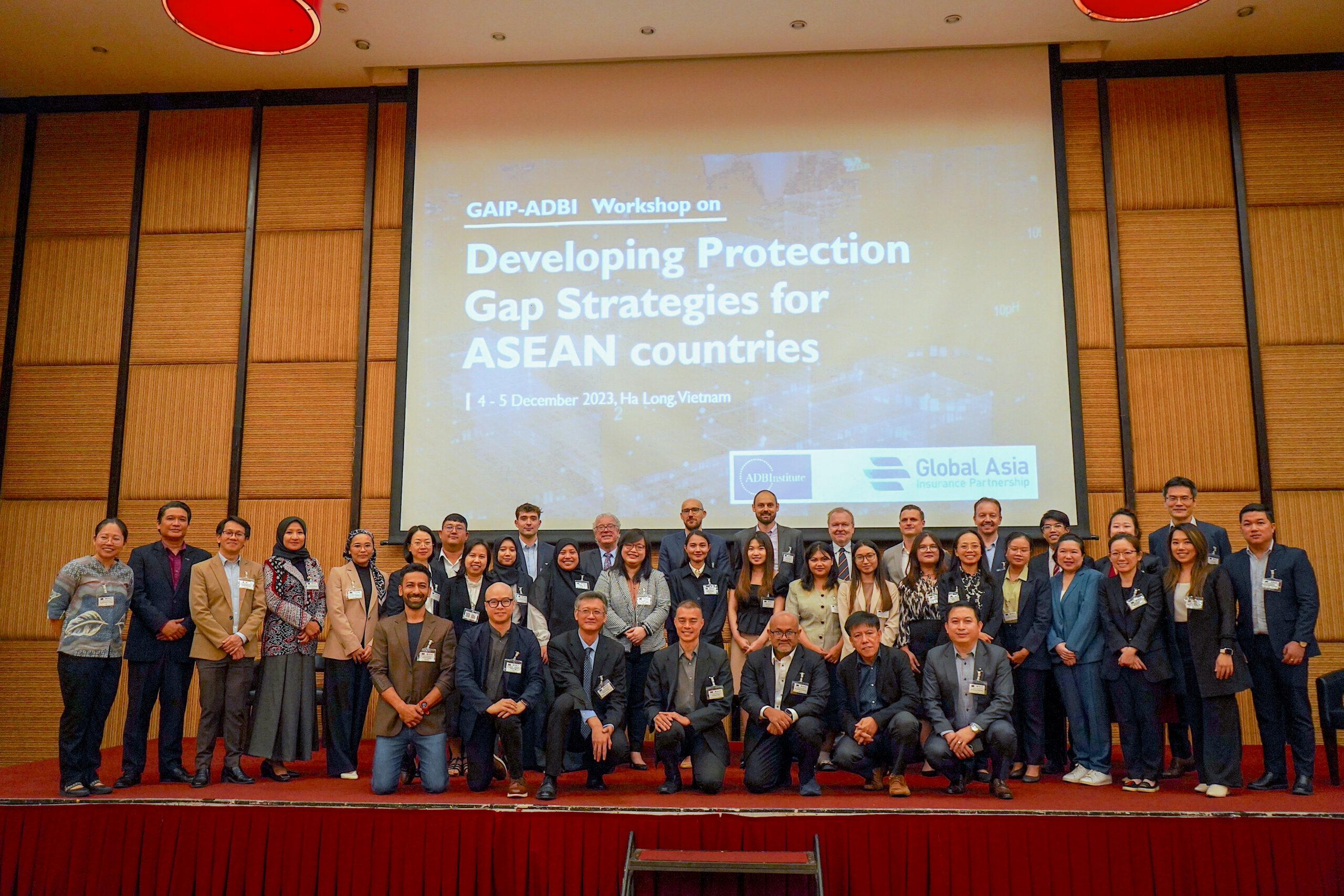The Global-Asia Insurance Partnership (GAIP), in collaboration with the Asian Development Bank Institute (ADBI) and ASEAN Secretariat, co-hosted a workshop on “Developing Protection Gap Strategies for ASEAN Countries“. The 2-day workshop was held in Viet Nam on 4 and 5 December 2023.
The workshop started with an explanation of the protection gap by illustrating different perspectives, followed by a comprehensive overview of efforts around risk reduction, risk financing, insurance penetration, and Public-Private Partnerships (PPPs). The speaker emphasised the creation of collaborative partnerships that effectively harmonised diverse objectives.
Next, the session delved into the social dimensions of disasters and adaptive social protection, exploring variations and similarities in different protection systems. The adequacy, coverage, and humanitarian gaps were discussed, along with aspects of disaster risk finance and adaptive social protection in the Asian context. The importance of the Adaptive Social Protection system and its connection to people's vulnerability was also discussed.
The next session began by highlighting opportunities and challenges presented through different perspectives and examples. Addressing opportunities, a significant shift in risk ownership was emphasised, focusing on the importance of financial considerations and the challenge of establishing effective public-private partnerships.
The relatively low social protection rate in ASEAN countries suggested room for improvement. Vietnam's attainment of a 90% health insurance access rate and the Philippines' implementation of a public employment and health program for disaster recovery were shared as advancements.
The advantages of Thailand‘s Universal Health Coverage (UHC) and the critical role of information and data management in combating pandemics were also underscored. The speakers discussed government involvement, opportunities in subsidized programs, encouragement of public insurance, and the high product range of insurance in Asia.
Regarding challenges, there were concerns about the time taken for health infrastructure development, the vulnerability of migrant workers, awareness gaps in UHC, and the risk of government corruption due to substantial payments in national UHC. A participant highlighted the breakdown of the demand side into vulnerability, product and service quality, and trust from an insurance perspective. That said, the value and importance of insurance were emphasised, and the equal significance of planning the process alongside forward planning was highlighted.
The workshop participants then engaged in discussions about their specific circumstances in their own country and shared insights from initiatives aimed at addressing protection gaps, before deliberating on the essential components of regional and/or national protection gap strategies, with a specific focus on the pivotal role of adaptive social protection.
The discussions centred around social awareness issues prevalent in many Asian countries, particularly the lack of knowledge among agriculture workers about insurance and their rights and challenges such as the reluctance of insurance companies to provide products for farmers due to perceived risks.
Additionally, collaboration among the Ministries of Finance, Social Affairs, and Health, aiming to connect public health schemes with private health initiatives, was also discussed. A focus on increasing micro-insurance penetration, with insurance companies distributing their products through local social organizations, was also discussed.
A regional protection scheme was strategised by identifying target groups, tools, key risks, and priorities for both country-level and regional adaptive social protection policies. Avenues for government funding in insurance were discussed and leveraging insurance with government support was proposed to ensure payments without double payment, relying on the capacity of insurance companies.
On Day 2, one of the speakers discussed the importance of government intervention using a combination of financial instruments to finance contingent liabilities cost-effectively. The need to assess risks associated with target groups, assets, and events and prioritise public strategies to reduce the protection gap was emphasised. The increase in risk awareness could potentially drive demand for insurance, leading to a reduction in the social protection gap.
The ASEAN Disaster Risk Financing and Insurance (DRFI) initiative, driven by the ASEAN Cross-Sectoral Coordination Committee (ACSCC), and the Resilient Planet Data Hub which was convened by the UN Office for Disaster Risk Reduction, the Insurance Development Forum, and the University of Oxford, were introduced at the workshop.
The DRFI initiative aims to support disaster management officers, insurance regulators, and financial officials, contributing to regional and sub-regional risk reduction solutions, while the Resilient Plant Data Hub was established primarily to address existing data gaps. The Hub was noted as a valuable tool to facilitate investors' adaptation finance decisions.
Another speaker deliberated on data analysis for useful decision-making, addressing key questions related to decision-making processes, targeted protection, assets to protect, implementation methods, and the selection of appropriate tools, suggesting that both the value and flow of money should be considered in the decision-making process.
The last session of the workshop delved into what the stakeholders would need in developing strategies, actions, and initiatives to address protection gaps. Participants started with a focus on identifying the individuals responsible for addressing the protection gap, categorizing them into core, involved, and informed teams, and understanding their respective roles. The participants were asked to use an empathy-building method to delve deeper into stakeholder activities.
In conclusion, the workshop was a testament to the commitment and collaboration needed to create positive change in disaster risk management and in addressing protection gaps in ASEAN countries.
